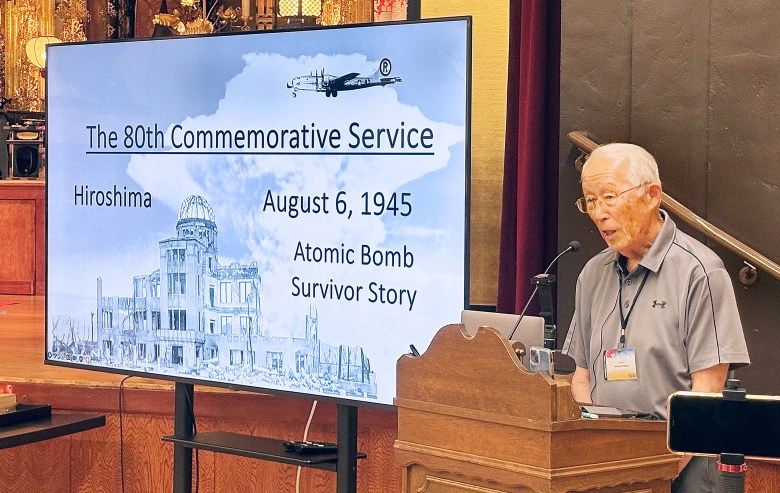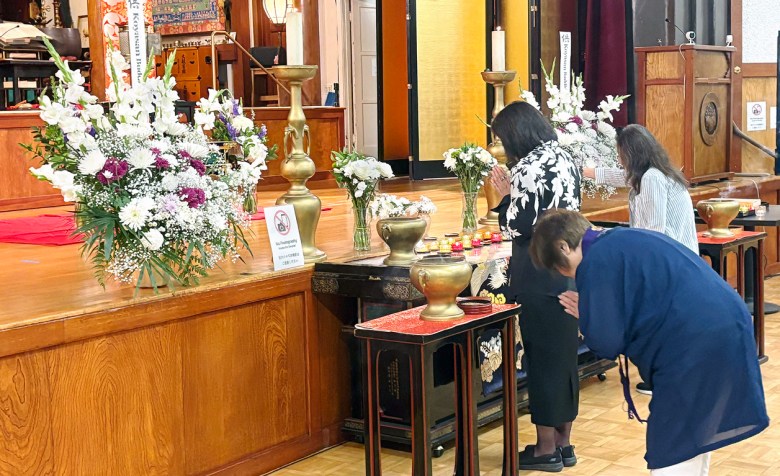 Photos by J.K. YAMAMOTO / Rafu Shimpo
Photos by J.K. YAMAMOTO / Rafu Shimpo
Hiroshima survivor Howard Kakita shared his story.
By J.K. YAMAMOTO
RAFU STAFF WRITER
The 80th commemorative service of Hiroshima-Nagasaki atomic bomb victims and survivors took place on Aug. 3 at Koyasan Beikoku Betsuin of Los Angeles in Little Tokyo.
The U.S. bombed Hiroshima and Nagasaki on Aug. 6 and 9, 1945, killing more than 210,000 people by the end of that year. While many were killed instantly, others died later from exposure to radiation. Locally, a commemoration is held every August by the American Society of Hiroshima-Nagasaki A-Bomb Survivors (ASA).
Koyasan is home to the Hiroshima Peace Flame, which was ignited in 1984 from the Peace Flame that burns in Hiroshima Peace Memorial Park. The flame has resided at the temple since 1989.
The officiant was Rinban William Briones, head minister of Nishi Hongwanji Buddhist Temple and president of the Los Angeles Buddhist Temple Federation.
Participating ministers were Rev. Mayuki Nagamine, Higashi Honganji Buddhist Temple; Rev. Junkyo Murakami and Rev. Yuki Himeji, Nishi Hongwanji; Rev. Nobuko Miyoshi, West Covina Buddhist Temple; Rev. Shumyo Kojima, head minister, Zenshuji Soto Mission; Rev. Yuryu Mori, Rev. Brandon Chikyo Paris and Rev. Johnny Eijun Vuong, Koyasan.
Chairpersons of the service were Regina Sakurai, Koyasan president; Dr. Gloria Montebruno-Saller, ASA vice president; and Darrell Miho, ASA director.
The service included tolling of the bell, incense offering by the officiant and ministers. Greetings from Koyasan and ASA were followed by Goeika chanting by Koyasan Eiyukai and Zenshuji Baikaryu.
 Members of the public offered incense in front of the Peace Flame.
Members of the public offered incense in front of the Peace Flame.
Among those making candlelight offerings were:
Tateo Ohashi, consular section head, Consulate General of Japan;
Tami Omoto-Frias, senior deputy, Los Angeles County Board of Supervisors, District 1;
Kihei Otani, president, Nanka Kenjinkai Kyogikai;
Shuto Habu, president, L.A. Nagasakikai;
Patricia Wyatt, president and CEO, Japanese American Cultural & Community Center;
Kristen Hayashi, director and curator, Japanese American National Museum;
Michael Okamura, president, Little Tokyo Historical Society;
Midori Tachibana, president, and Farida Futouhi, peace chair, Rotary Club of Little Tokyo;
Video messages from Hiroshima Mayor Kazumi Mori and Nagasaki Mayor Shiro Suzuki. Rev. Kaizan Kosaka delivered messages on behalf of Abbot Shindo Hasebe, head of Koyasan Headquarters, and Bishop Shunga Kiryu, director of international affairs at Koyasan Headquarters.
Rotary Club of Little Tokyo presented “A Conversation About Peace” following the program.
Eyewitness Account
The guest speaker was Howard Kakita, a Hiroshima survivor and advocate for nuclear disarmament. Born in California and raised in Japan during World War II, he experienced the horror of the atomic bombing firsthand, surviving despite being just 0.8 mile from the hypocenter.
Kakita recalled that he and his younger brother Kenny were taken to Hiroshima by their parents in 1939 to visit their ailing grandfather. In 1940, the parents had to return to California and left Kakita and his brother in the care of their paternal grandparents. The plan was for the parents to return shortly, but then the war broke out.
On the morning of Aug. 6, 1945, Kakita and his brother heard the U.S. B-29 bomber overhead and went outside to look while their grandmother was washing dishes in the kitchen. He was knocked unconscious by the blast, and when he came to he was buried under debris but not seriously injured. Miraculously his brother and grandparents also survived, though his grandmother was hit by several shards of glass.
Every structure in the neighborhood was on fire. Some people were trying to put out the fires, not realizing that the entire city was ablaze. His grandfather told his grandmother to take the two boys up to the mountain.
Along the way, Kakita experienced “a sea of carnage” — people with skin dripping from their bodies or with their guts hanging out. Some begged for water. Kakita was told not to give them water because it could kill them, but he saw them die whether they received water or not.
Eventually the three found a functioning train station and were able to leave the city and stay with relatives. Kakita later learned that his maternal grandparents had perished. Uncle survived but was seriously ill due to radiation exposure.
In late August, Kakita returned to Hiroshima to find the city completely leveled. Not all of the bodies had been removed, though several had been cremated.
Meanwhile, Kakita’s parents were incarcerated at Poston in Arizona for the duration of the war. In 1948, Kakita and his brother were sent back to their parents, though by that time the siblings were used to living in Japan and no longer spoke English. Despite a difficult adjustment, Kakita later earned engineering degrees from UCLA and built a successful career.
Since joining ASA in 2008, Kakita has shared his story at schools and public events as he campaigns for nuclear disarmament. He noted that there are now about 13,000 nuclear weapons, with the U.S. accounting for over 5,000, each much more powerful than the ones that destroyed Hiroshima and Nagasaki.
Emphasizing “our shared responsibility to stop the proliferation of nuclear weapons,” Kakita said that eventually “many of us (survivors) will not be here,” but he hopes that future generations will not have to live under the threat of nuclear annihilation.
Articles for you


AloJapan.com